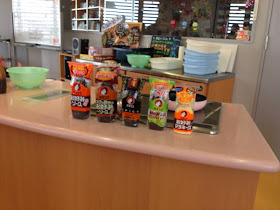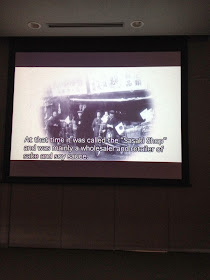Like any smart, well-known company, Otafuku (prounced oh-tah-foo-koo, meaning a beautiful, charming woman ... like a Japanese Cleopatra) offers a tour of their headquarters. We had been looking for a cooking class and Chie recommended this tour... and I am glad she did. It was a great way to spend the day, and 700 yen (about $7), and well worth both the time and the money.
 It took abut an hour and 15 minutes to drive to the factory, which is near Alpark Mall. You may have seen the Wood Egg Museum, which is where our tour began. I have no idea what wood eggs have to do with vinegar and sauces, but that was the shape of the building. Other than that, as far as I know, there was no more mention of wood or eggs, other than the egg that was added to our okinomiyaki dish during the cooking class.
It took abut an hour and 15 minutes to drive to the factory, which is near Alpark Mall. You may have seen the Wood Egg Museum, which is where our tour began. I have no idea what wood eggs have to do with vinegar and sauces, but that was the shape of the building. Other than that, as far as I know, there was no more mention of wood or eggs, other than the egg that was added to our okinomiyaki dish during the cooking class.A sign welcomed us, as well as a couple of Japanese families who toured with us. We weren't on an official base cultural tour or anything, but I guess they needed to define us and our lack of Japanese language knowledge in some way. I forgot to ask Chie what that last kanji character after Iwakuni base means, but maybe it is "wives."
But we avoided the holidays by going today and Chie booked space for eight of us back in January. You will need a Japanese translator to make the reservation, so I recommend going to ITT (in Crossroads Mall) and ask them to make the call for you, which is 082-277-7116. ITT will ask to use your cell phone to make the call.
The history of this company is interesting... but they apparently realize that if you have a full stomach you will be more amenable to hear about it. So, on the tour, the cooking and eating come first. Bring an apron and a bandanna for your head. These are required. You can get bandannas at the Daiso for about $1. Don't we look cute? Someone made a Laverne & Shirley reference on Facebook... we were at a factory, after all.
Also to note: Nearly everything is available in English, except when the tour guide actually speaks to you on the tour of the factory and about the history of the company, and when the cooking instructions are given by your instructor. However, a DVD is played before the tour and it is subtitled in English (when you book the reservation, make sure to request it), so we learned most of what was shared on the tour, Chie said. The information the tour guide shared was simply in a bit more detail. As for the cooking lesson, the dish is easy to make and 95 percent of it is visual, so you will do just fine by watching, even if you don't understand what is being said.
Everything was out and ready for us... and we were welcomed with personalized chopstick holders.
The kitchen was set up with five stations, plus the instructors' station at the front. Each station was for four people, so only 20 people at a time can go on the tour. The television screen is from an overhead camera, showing what the instructor is doing.
The way the cabbage is cut is very important, because the strings of cabbage need to be thin to steam properly while cooking.
The plates were labeled with the company's name... and were available in the gift shop. ;)
To make things easy, all non-perishable items are in one convenient bag, and instructions are provided both by the museum and in picture form on the back of the bag. The Americans were very happy.
Essentially, you take the ingredients, starting with pancake batter, and stack them. Pancake batter, fish flakes, cabbage...
Crunchy kernels of something, squid crackers, green onions...
Bean sprouts...
Pork strips (think bacon)...
Drizzle some pancake batter on top of the meat. With the use of two special okinomiyaki spatulas (also available in the gift shop, with the Otafuku logo on them), you flip the whole thing over and turn the griddle up a little hotter so the meat can cook.
Slide the okinomiyaki over to a corner and the cook up some noodles...
Drizzle on some okinomiyaki sauce... Otafuku original, of course...
Mix the sauce in to the noodles while they brown and then put your okinomiyaki, meat side down, on top of your noodles... make sure the meat is cooked thoroughly first! And, of course, you get a picture of your perfectly browned pancake bottom.
Cook an egg in a circle a little wider than your okinomiyaki...
Quickly put your okinomiyaki on top of the cooking egg. Pat the okinomiyaki with the spatulas so that it is very flat.
Cut it up with the spatulas while it is still on the griddle, and then transfer the pieces to a plate. Then the real fun begins: Choosing your sauces! I chose the sweet sauce and regular mayonnaise.
While the sauce presentation was in Japanese, many of the words used for the explanation of the sauces were in English. Like "spicy sauce." No kidding.
From left to right: Original okinomiyaki sauce, sweet okinomiyaki sauce, spicy okinomiyaki sauce, half the calories okinomiyaki sauce, and, finally, mayonnaise (they also have babies' mayo and no-egg mayo.) Side note: If you would like to learn more about Japanese sauces, the Iwakuni Foodie does a great job explaining some of the popular ones here.
Bon appetit! They also made a shrimp dish for us to try, using sauce and mayo. The English recipe was included with our visit.
Once we got fat and happy on the okinomiyaki we made, we helped the instructors by cleaning the dishes we used at our station. This has been standard in all of the cooking classes I have taken in Japan: You help clean up your own mess. Once that was complete, off came the bandannas and aprons, and away we went on the tour of the museum and factory.
As mentioned the video was in Japanese, but had English subtitles... very accommodating to us Americans and we made sure the tour guides knew how much we appreciated it! We literally all cheered to show our joy and happiness.
I won't go in to all of the history here, but there are some definitely good facts to note:
The company was founded in 1922 in Hiroshima, as a sake and soy sauce retailer. It started making vinegar in 1938. The factory was destroyed by the atomic bomb in 1945, but the company started making vinegar again a year later. While okinomiyaki had been a popular dish for decades, the Japanese stopped making it during the war because the metal from the pans required to make the dish was needed for weapons. After the war, because of American influence, Western foods became more popular and sauces were needed. The company began making Worcestershire sauce in 1950, but failed to sell it because there were other well-known sauce companies already making it. Meanwhile, America was sending food to Japan during the recovery effort and wheat flour was one of the things sent. Okinomiyaki was one of the few easy, familiar dishes that the Japanese could make using the flour. One restaurateur customer complained to the Otafuku company that Worcestershire sauce was too thin to cook properly, that a thicker sauce was needed. The company listened to the customer and that's how okinomiyaki sauce came to be.
The process of making the sauce was broken in to five categories.
There are more than 50 ingredients in okinomiyaki sauce, including dates (imported from America!), apples, onions, tomatoes, and a few dozen spices. There are no preservatives in the sauces, so they are sterilized with boiling heat. The sauce is good for two years unopened or for 3 months opened and kept in the fridge. There are three different Otafuku factories in Japan, and the tour guide and video both made a point to explain how protection of the environment and food safety are very important to the company.
After the roughly 7-minute video, we were off to see the museum, which had replicas of how okinomiyaki restaurants worked in the 1950's. Some families had a large griddle on the front porches of their homes, serving customers from there.
Others had rolling cards with portable walls complete with a hanging basket to put the money in. Many women widowed by the war ran these to support their families.
I won't ruin to tour for you, but there are a lot of interactive displays explaining the history of okinomiyaki and the company, some of the information is in English.
Again, emphasizing food safety, this mannequin/dummy was on display to show what the factory works wear. These sterile suits have no pockets... how would you like to find a pen or paper clip in your sauce? Instead, the workers have zippered fanny packs.
We saw the bottling process, which was full of automation. While we were there there was a jam on the assembly line, apparently, and instead of buzzers going off, it was upbeat, chiming music. Nothing stressful like a siren or iPhone alarm alert. Happy, chiming music. And the factory works ran to fix the problem.
In the shipping area, rolling, flat-bed robots carried the boxes of sauce to the conveyor belts and automated cranes with monkeys and giraffes on them put the boxes on pallets, ready for the trucks to carry them to distributors.
As part of our tour, we got a fresh - made today and still warm! - bottle of sauce, straight from one of the boxes.
But the gifts didn't stop there... we also got goodie bags with vinegar, an okinomiyaki kit...
... and a photo of us from earlier in the day. Inside the paper were more recipes... in English. :)
The goodies alone paid for the price of admission, not to mention the lunch, lesson and tour. Of course, no museum worth its salt skimps on a trip to the gift shop, so that is where we ended our tour. I did buy some spatulas with the logo on them as a souvenir, and some food stuffs so I could easily make okinomiyaki for the family later this week.
And we made sure to get photo opps with the sauces... thank you to Brenda for demonstrating. ;)
Added 3/27/14: Chie got a note in the mail from Otafuku, thanking us for visiting the company. A very nice touch.













































No comments:
Post a Comment